#Araripe Basin
Photo
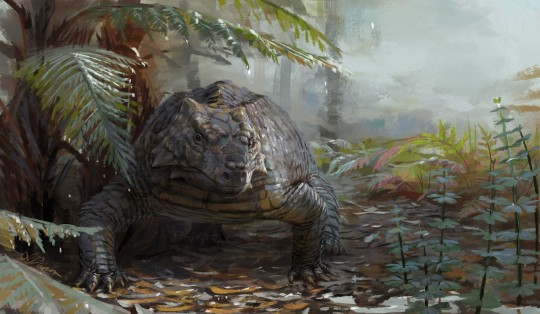

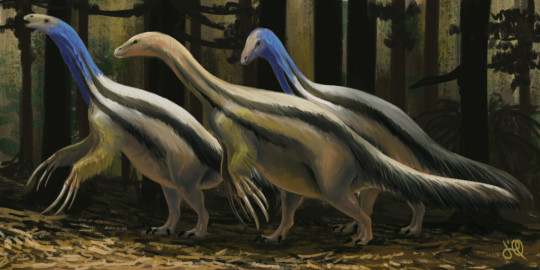
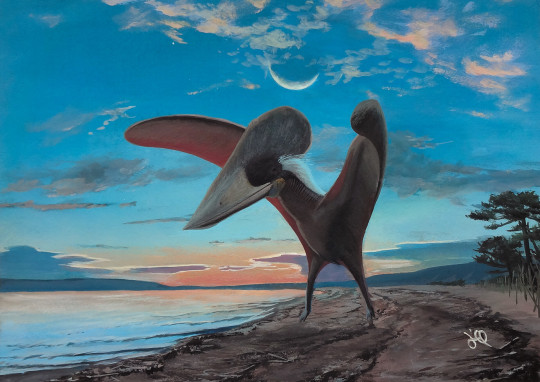

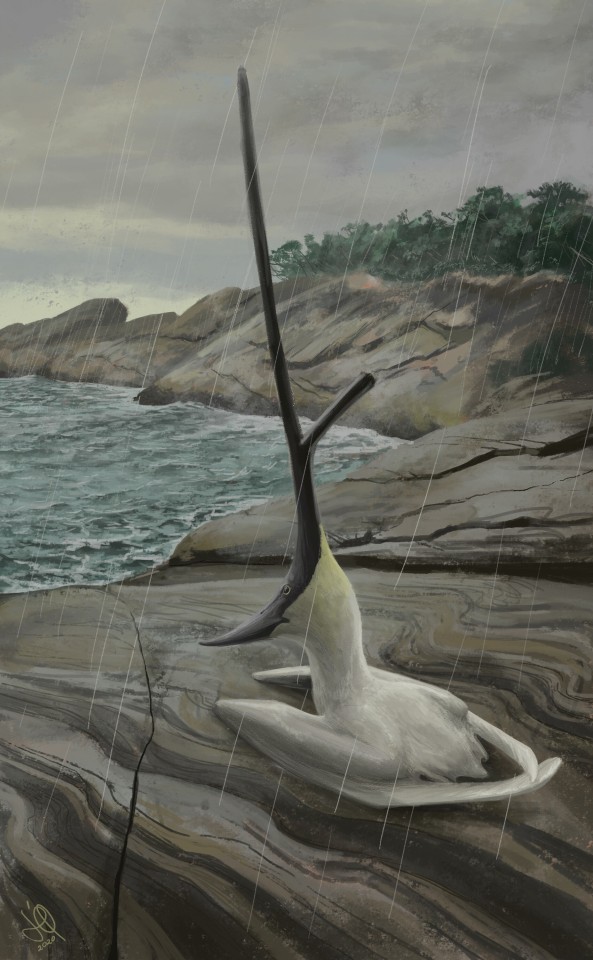


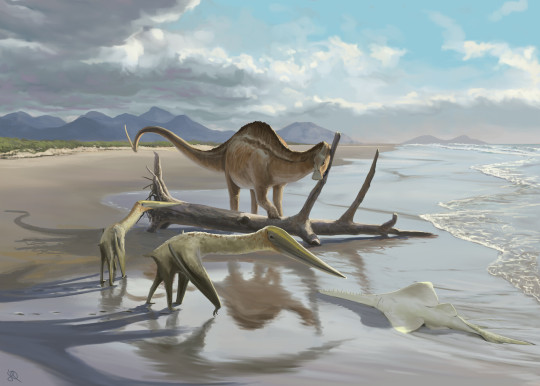

Paleoart by Júlia d'Oliveira.
Provelosaurus, a Brazilian pareiasaurid reptile from the Permian period.
Kariridraco dianae, a new species of pterosaur from Araripe Basin, Brazil.
Therezinosaurus.
Waxing Crescent. Tupuxuara landing at nightfall.
Waxing Gibbous: A Tupandactylus navigans couple flying over the Crato landscape.
Nyctosaur in the rain
A quick art of the newly described Tupandactylus navigans specimen.
Kurupi itaata, a newly described abelisaurid from the Late Cretaceous Marília Formation.
Afternoon at the beach. Inspired by a visit to a beach and the Kem Kem beds fauna.
Full moon at dawn. Caiuajaras singing a forgotten song as the moon sets and the sun rises.
#art#júlia d'oliveira#dinosaurs#pterosaurs#provelosaurus#kariridraco#therezinosaurus#tupuxuara#tupandactylus#nyctosaurus#kurupi#caiuajaras#paleoart
526 notes
·
View notes
Text
Massive dino from Brazil ate 'like a pelican,' controversial new study finds. Why is it causing an uproar?
The study reveals new information about the carnivorous dinosaur Irritator challengeri, but the research has been criticized because the fossils may have been illegally removed from Brazil.

A large predatory dinosaur related to Spinosaurus may have scooped up prey "like a pelican" by extending its lower jaw, European researchers propose in a new study. But the findings have upset some paleontologists who contest that the fossils were illegally taken from Brazil and should be returned to their country of origin.
The dinosaur at the center of the controversy is Irritator challengeri, a member of the family Spinosauridae — a group of bipedal, carnivorous dinosaurs with long, crocodilian-like snouts. The species, which grew to a max length of around 21 feet (6.5 meters), was first described in 1996 from 115 million-year-old fossils uncovered in the Araripe Basin of northeastern Brazil and later shipped to Germany, where they now reside in the Stuttgart Museum of Natural History in the state of Baden-Württemberg.
In the new study, which was published in the journal Palaeontologia Electronica, researchers digitally reconstructed the skull from the I. challengeri specimen housed in Stuttgart and discovered that the species' lower jaw could spread out to the sides, widening the animal's pharynx, the area behind the nose and mouth. This is similar to how a pelican widens its lower beak to scoop up small fish, suggesting that I. challengeri likely fed in the same way, the researchers wrote in a statement.
The new analysis also revealed that, due to its eye placement, I. challengeri would have naturally inclined its snout at a 45-degree angle and been capable of rapid-yet-weak bites. When combined, these features suggest that the snout would have been well suited to quickly scooping prey out of shallow water, the researchers wrote.
I. challengeri's journey from Brazil to Germany is a contentious one. The fossils were unearthed by nonscientific commercial diggers and were sold to the Stuttgart Museum before 1990, when Brazil began restricting scientific exports to other countries. As a result, the study's researchers believed that the fossils legally belonged to the Baden-Württemberg state.
However, an older Brazilian law dating to 1942 states that Brazilian fossils are federal property and cannot be sold, meaning that the fossil was technically stolen by the commercial diggers who exported it, Juan Carlos Cisneros, a paleontologist at the Federal University of Piauí in Brazil who was not involved in the new study, told Live Science in an email. "And buying something stolen does not make you its owner," he said.
Continue reading.
#brazil#germany#politics#science#paleontology#dinosaurs#brazilian politics#german politics#mod nise da silveira#image description in alt
62 notes
·
View notes
Photo

(Note: I am not a professional paleontologist or even biologist. I am just and amateur paleoartist and enthusiast. If my infos are off in some way, feel free to correct them ^^)
-
DINOCEMBER
11 - Ubirajara jubatus (from Tupi “lord of the spears”)
- Early Cretaceous (110 Ma BCE)
- Crato Formation, Ceará, Brazil
Named at the end of 2020, Ubirajara is one of the most impressive fossils found in Brazilian territory, being a member of the Compsognathidae, small theropods covered with proto-feathers - or "dino-fuzz" - related to raptors and tyrannosaurs, whose most famous members are China's Sinosauropteryx and Germany's Compsognathus itself. Described from a partial skeleton without the skull, Ubirajara presents impressions of its fuzz, having an apparent "mane" in its dorsal region and pairs of quills on its shoulders, similar to what is found in the current birds-of-paradise, probably used in courtship or to intimidate rivals.
The Crato Formation, as well as most of the formations in the Araripe Basin, would be the margins of a large saltwater lagoon, as well as a system of rivers surrounded by gymnosperms and some of the first flowering plants, being rich in fossil extract, especially of pterosaurs, and some curious animals, like the Enantiornithe Cratoavis. Unfortunately, Ubirajara, like other Brazilian fossils, is a target of international fossil trafficking, not having a single native author in the paper that describes it, with the team led by David Martill, a German paleontologist who smugled the Ubirajara fossil to Germany in 1995, and he cannot set foot on Brazilian territory for this and other crimes. Since its description, Ubirajara has been the target of campaigns for its repatriation, as well as other national fossils. I use this drawing as my collaboration for the campaign, and that so that this colonialist and criminal mentality ceases to exist in the paleontological community.
- Ubirajara’s color scheme inspired by a Vinaceous-breasted Amazon (Amazona vinacea) and a Vulturine Parrot (Pyrilia vulturina) and Cratoavis’ colors isnpired by a Black-thorated trogon (Trogon rufus). All of them are Brazilian birds
#UbirajaraBelongstoBR#ubirajara jubatus#ubirajara#theropod#compsognathus#compsognathidae#coelurosauria#feathered dinosaurs#Brazil#brazilian dinosaurs#dinocember2020#dinovember#Cratoavis#Crato Formation#Araripe Basin#creature design#creature art#creature concept#dinosaur#paleobiology#paleontology#paleoart#paleoillustration#sciart#science illustration
7 notes
·
View notes
Text
Episode 297: Velociraptor with double sickle claws or friendly Dodoraptor?
I Know Dino #Podcast Episode 297: Velociraptor with double sickle claws or friendly Dodoraptor? Balaur bondoc is a mysterious #dinosaur that lived with a dwarf sauropod on the European Hațeg Island.
Episode 297 is all about Balaur, the “stocky dragon” from Hateg island, famous for its pair of sickle-shaped claws on each foot.
Big thanks to all our patrons! Your support means so much to us and keeps us going! If you’re a dinosaur enthusiast, join our growing community on Patreon at https://www.patreon.com/iknowdino.
You can listen to our free podcast, with all our episodes, on Apple…
View On WordPress
#Araripe#Aratasaurus#australia#Balaur#Basin#Bass Coast#bondoc#Brazil#Cabazon#california#claws#Coelacanth#Cretaceous#Curiosity#damage#diet#dinosaur#dinosaur of the day#dinosaurs#dragon#Ebola Rex#finned#fins#flightless#game#ghost#Hateg#i know dino#island#Jurassic
2 notes
·
View notes
Text
Pterosaurs may have flaunted colorful plumage long before the reign of dinosaurs | Science

The idea that dinosaurs sported colorful feathers, once outlandish, has become conventional wisdom. Now, a new study of a Brazilian fossil suggests that pterosaurs—leathery winged, flying reptiles only distantly related to dinosaurs—were also clad in tiny feathers of varying hues. The finding suggests feathers may have evolved more than 150 million years before the heyday of the dinosaurs, probably for display, the authors say. “In their very earliest forms, feathers were colored … presumably for signaling,” says paleobiologist Maria McNamara of University College Cork, who led the study.
The paper “reinforces the idea that pterosaurs were ‘fluffy,’ and indicates at least some of them probably had complex colorful patterns—which is fantastic,” says Rodrigo Pêgas, a paleontologist at the Federal University of ABC, São Bernardo do Campo, in Brazil. But Pêgas is not convinced that feathers originated as early as McNamara thinks—and some other researchers doubt the structures are feathers at all.
How feathers arose has been a big question in paleontology for more than 150 years, since the first Archaeopteryx—a feathered dinosaur once thought to be the first bird—was found in Germany. Many researchers think feathers arose for insulation and were co-opted only much later for flight and other uses, such as courtship displays. As for pterosaurs, researchers had previously reported their bodies were covered in pycnofibers, single-stranded structures that formed a “fuzz,” presumably for warmth.
Then in 2018, McNamara and her colleagues reported that two well-preserved Chinese pterosaurs showed what seemed to be a defining feature of feathers: a central shaft with branches. Some paleontologists were skeptical, and McNamara says she understood why. “Their feathers were—to be honest—a bit weird,” she says. “They didn’t branch like modern bird feathers do.”
Now, she and her colleagues have cemented their arguments with a paper this week in Nature analyzing the soft tissue of an exquisitely preserved skull of Tupandactylus imperator—a pterosaur that had a majestic head crest and a 5-meter wingspan. It lived 113 million years ago in what is now the Araripe Basin in northeastern Brazil, although McNamara studied the fossil in Belgium. The team thinks it was poached from Brazil and kept in private collections until recently. Earlier this year, the Royal Belgian Institute of Natural Sciences repatriated the fossil to Brazil, where it will be displayed at the Earth Sciences Museum in Rio de Janeiro. “It is great that the fossil is back in Brazil,” Pêgas says.
On the pterosaur’s head crest, the researchers identified both single-stranded fibers and featherlike branching ones with a central shaft narrowing at the base. Under the scanning electron microscope, both skin and feathers had melanosomes, intracellular structures containing melanin that give pigment to skin, feathers, and fur in living animals, with differently shaped melanosomes conferring different colors. The pterosaur’s melanosomes had diverse shapes—ovoid, spherical, and elongated—something until now only seen in mammalian fur and dinosaur and bird feathers.

Tupandactylus imperator, a large pterosaur that lived in what is now Brazil, may have sported a colorful head crest, as seen in this artist’s illustration.© Bob Nicholls 2022
The researchers think Tupandactylus’s colored, branching structures were indeed feathers, which both kept it warm and enabled it to signal to other pterosaurs, perhaps as male peacocks do by displaying plumage during mating.
The finding means feathers must have evolved far earlier than was thought, McNamara says. “The most parsimonious explanation is that feathers were present in the common ancestor of [pterosaurs and dinosaurs],” about 250 million years ago during the Triassic period.
Some paleontologists say the evidence of feathers is persuasive. “We’re hammering it in with 7-inch nails with these findings,” says Jakob Vinther, a paleobiologist at the University of Bristol. Paleontologist Michael Benton, also at Bristol, agrees, but “I don’t think pterosaur feathers had any function in flight because they’re just fluffy little feathers.”
But paleontologist David Martill from the University of Portsmouth says the small branched structures “look nothing like feathers.” He thinks they are a different kind of keratinous covering, though he agrees they were probably spectacularly colored.
Even if they are feathers, pterosaurs may not have flaunted them like Mesozoic peacocks, Vinther says. He notes that the researchers didn’t infer the melanosomes’ color and says it’s possible the plumage was used for camouflage rather than display.
Nor is it certain that the pterosaur structures share an ancient origin with those of dinosaurs and their descendants, living birds, some researchers say. “We still need fossil evidence for feathers in the Triassic as well as unequivocal molecular evidence for the common origin between pterosaur pycnofibers and dinosaur feathers,” Pêgas says.
McNamara promises more evidence for her scenario. Her team is working to characterize the detailed chemistry of the Tupandactylus samples, which could reveal organic compounds in the feathers.
If the current findings hold up, they may shed light on the selection pressures that shaped early feathers, says Jasmina Wiemann, a molecular paleobiologist at the California Institute of Technology. “Thermal regulation has been the old hypothesis out there … [but] maybe there’s more to it.”
New post published on: https://livescience.tech/2022/04/21/pterosaurs-may-have-flaunted-colorful-plumage-long-before-the-reign-of-dinosaurs-science/
2 notes
·
View notes
Photo

Gondwanagaricites magnificus was about 2 inches (5 cm) tall and grew 115 million years ago (Early Cretaceous epoch) in what is now northeast Brazil.
The specimen was found in the limestone of the Crato Formation in Brazil’s Araripe Basin. The gilled mushroom Gondwanagaricites magnificus lived during the Early Cretaceous, a time of dinosaurs when Gondwana was breaking apart.
Sci-News
5 notes
·
View notes
Photo
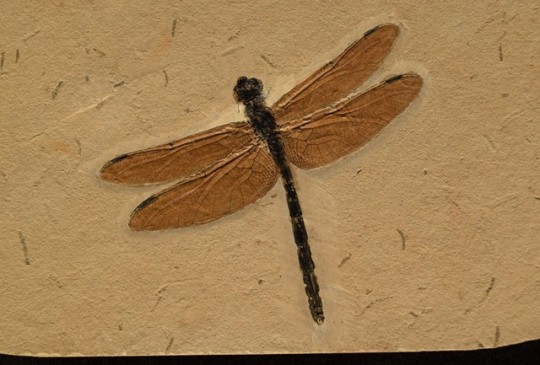
The Santana Formation
I'm always fascinated by taphonomy, the process of fossilisation, and how some rare sites throughout geological time have seen a concatenation of circumstances that resulted in high quality preservation, often including soft parts. These are known from the German as Konservat Lagerstätte, and famous examples include the Burgess shale (see https://bit.ly/Riw7KU) , the Solnhoffen lithographic limestone (see https://bit.ly/2uDerjw) and the Messel pit (see https://bit.ly/2A0Ge2A). The 10 cm across dragonfly in the photo came from one of these sites, preserved in the Araripe basin of north-eastern Brazil and dating from the mid Cretaceous of 110 million years ago. The formation was first found in 1819 and named after a nearby village, having been deposited in a shallow inland sea around the time that the South Atlantic was beginning to open up. The strata are complex and interleaved, reflecting the complex and fast changing environment of an opening sea. Ecosystems include lagoons and coastal flats with shallow water environments ever shifting in place, making for very varied and diverse facies across the formation.
The fauna is also diverse, including a diversity of fishes (some of which have their stomach contents preserved enabling food webs of the long gone past to be reconstructed), insects, many pterosaurs (for which it is famed in paleontological circles), reptiles and amphibians, conifers and the occasional bonus dinosaur. The flying pterosaurs are mostly fish eaters though terrestrial predators are also represented, and some have wingspans up to 8 metres across. Others were herbivorous, as attested by their mouthpart style.
Here the taphonomy consists of large limestone nodules encasing the fossils ensuring detailed preservation and protection from varied types of destructive force. Fossils from this historic site are now protected and exportation is off limits, as is usual in such sites to ensure the future growth o knowledge though there is sadly a thriving illegal trade. Remember that if you are caught with fossils from such places modern laws require their return, no matter whether bought in good faith or how much was paid for them.
Loz
Image credit: 1: LGF Foundation
https://lgfmuseum.org/#
https://bit.ly/2NoNyrk https://bit.ly/2IPsEyq https://bit.ly/2tPwqTE https://bit.ly/2tSxRAJ
86 notes
·
View notes
Photo

HAPPY #FossilFriday! Look at this GORGEOUS specimen! Allow me to gush. [LONG POST!] Anhanguera santannae (AMNH22555) is one of the BEST preserved pterosaur fossils in the world and we have been lucky enough to have it at the Cleveland Museum of Natural History for the last several months. It is SO rare to get this quality of preservation in the fossil record. Why? Taphonomy: the study of what happens to an organism after death. You have to die in the right time in the right place and then lie undisturbed for millions (MILLIONS!) of years until a bipedal ape finds you, digs you up and tries to makes sense of you. Paleontologists really are superheroes when you think about it. This pterosaur and many other beautifully preserved three-dimensional fossils have been found in carbonate concretions in the Romualdo Member of the Santana Formation (Araripe Basin, northeastern Brazil). Some 25 species of fossil fishes have often been found with stomach contents preserved, helping paleontologists to better study predator–prey relationships. Pterosaurs, reptiles, amphibians, invertebrates, crocodylomorphs, plants, and even dinosaurs have been found here. Limestone accretions formed nodules around dead organisms, preserving soft and hard parts of their anatomy. These nodules are then taken to a lab and etched away with acid, revealing beautiful bone inside. The American Museum of Natural History (@amnh) creates traveling exhibitions of incredible quality (we've had several now!) and I can't wait to see what they have in store for the future! 📷 1-4: mine 📷 5: Pinheiro 2017 from https://peerj.com/articles/3285/ #pterosaurs #anhanguera #museum #naturalhistorymuseum #science #cle #fossil #fridayfeeling #notadinosaur #wearestemsquad #wearescience #scicomm #amnh #cleveland
#fossilfriday#pterosaurs#anhanguera#museum#naturalhistorymuseum#science#cle#fossil#fridayfeeling#notadinosaur#wearestemsquad#wearescience#scicomm#amnh#cleveland
8 notes
·
View notes
Text
Irritator was a spinosaurid dinosaur that lived in what is now Brazil about 110 million years ago, during the Early Cretaceous. It is known from a nearly complete skull found in the Romualdo Formation of the Araripe Basin. The genus name reflects the irritation of paleontologists who found that the skull had been heavily damaged and altered by collectors. Estimated at between 6 and 8 meters (20 and 26 ft) in length, Irritator weighed around 1 tonne (1.1 short tons), making it one of the smallest spinosaurids known. Its long, shallow and slender snout was lined with straight and unserrated conical teeth. Lengthwise atop the head ran a thin sagittal crest, to which powerful neck muscles were likely anchored. A generalist diet—like that of today's crocodilians—has been suggested. Irritator inhabited the tropical environment of a coastal lagoon surrounded by dry regions. It coexisted with other carnivorous theropods as well as turtles, crocodyliforms, and a large number of pterosaur and fish species.
0 notes
Text
Wikipedia article of the day for April 19, 2019

The Wikipedia article of the day for April 19, 2019 is Irritator.
Irritator was a spinosaurid dinosaur that lived in what is now Brazil about 110 million years ago, during the Early Cretaceous. It is known from a nearly complete skull found in the Romualdo Formation of the Araripe Basin. The genus name reflects the irritation of paleontologists who found that the skull had been heavily damaged and altered by collectors. Estimated at between 6 and 8 meters (20 and 26 ft) in length, Irritator weighed around 1 tonne (1.1 short tons), making it one of the smallest spinosaurids known. Its long, shallow and slender snout was lined with straight and unserrated conical teeth. Lengthwise atop the head ran a thin sagittal crest, to which powerful neck muscles were likely anchored. A generalist diet—like that of today's crocodilians—has been suggested. Irritator inhabited the tropical environment of a coastal lagoon surrounded by dry regions. It coexisted with other carnivorous theropods as well as turtles, crocodyliforms, and a large number of pterosaur and fish species.
from Blogger http://bit.ly/2GwpZM1
via IFTTT
0 notes
Photo

The Wikipedia article of the day for April 19, 2019 is Irritator.
Irritator was a spinosaurid dinosaur that lived in what is now Brazil about 110 million years ago, during the Early Cretaceous. It is known from a nearly complete skull found in the Romualdo Formation of the Araripe Basin. The genus name reflects the irritation of paleontologists who found that the skull had been heavily damaged and altered by collectors. Estimated at between 6 and 8 meters (20 and 26 ft) in length, Irritator weighed around 1 tonne (1.1 short tons), making it one of the smallest spinosaurids known. Its long, shallow and slender snout was lined with straight and unserrated conical teeth. Lengthwise atop the head ran a thin sagittal crest, to which powerful neck muscles were likely anchored. A generalist diet—like that of today's crocodilians—has been suggested. Irritator inhabited the tropical environment of a coastal lagoon surrounded by dry regions. It coexisted with other carnivorous theropods as well as turtles, crocodyliforms, and a large number of pterosaur and fish species.
0 notes
Text
Maned dinosaur fossil will head back to Brazil after controversy over import to Germany
Science story prompted German officials to investigate how rare fossil landed in a local museum
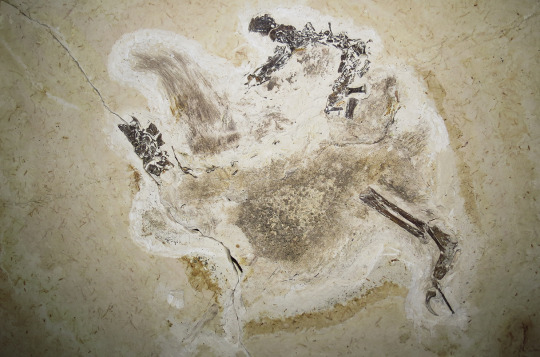
More than a decade ago, a 110-million-year-old dinosaur fossil was taken from its resting place in the Araripe Basin in Brazil under murky circumstances. Eventually, it landed in the State Museum of Natural History Karlsruhe (SMNK) in Germany—without legitimate export permits or clear documentation of its acquisition. Now, the specimen will go back to Brazil, German authorities announced today.
"We have a clear stance. … If there are objects in the collections of our museums that were acquired under legally or ethically unacceptable conditions, we will return them,” Theresia Bauer, who leads the Ministry of Science, Research and Arts for the German state of Baden-Württemberg, said in a statement to Science. Her ministry manages SMNK.
The decision “is admirable,” says Felipe Pinheiro, a paleontologist at the Federal University of Pampa, São Gabriel, who with others had pushed for the return of the fossil on social media. “As a Brazilian researcher, [I] am immensely happy that [the specimen] is going home.”
The ministry’s decision is an “emblematic” victory against colonialism in science, says Aline Ghilardi, a paleontologist at the Federal University of Rio Grande do Norte. “We have taken another step towards a real 21st century science … which is getting rid—even if slowly—of colonialist ties and biases,” she adds.
The official announcement closes a contentious chapter in the fossil’s history. In 2020, researchers at SMNK published a paper (with no Brazilian authors) in Cretaceous Research describing the dinosaur as a new species they named Ubirajara jubatus. The report attracted attention because the small dinosaur sported filaments apparently resembling mammalian fur, as well as flamboyant spikes erupting from its shoulders. But the researchers came under fire when Brazilian paleontologists alleged the fossil had been exported illegally. The journal withdrew the paper permanently in September 2021.
Continue reading.
#brazil#politics#germany#science#biology#paleontology#brazilian politics#german politics#ubirajara#international politics#mod nise da silveira#image description in alt
6 notes
·
View notes
Photo

(Note: I am not a professional paleontologist or even biologist. I am just and amateur paleoartist and enthusiast. If my infos are off in some way, feel free to correct them ^^)
-
DINOCEMBER
14 (Front) - Santanaraptor placidus (from the Latin "Thief of Santana")
15 (Back) - Aratasaurus museunacionali (combination of Tupi "ara" and "atá" and Greek "sauros" as "lizard born from fire")
- Early Cretaceous (112-108 Ma BCE)
- Romulado Formation, Ceara, Brazil
Probably one of the most famous Brazilian dinosaurs, the Santanaraptor is a member of the tyrannosauroid family, presenting more basal characteristics similar to the Asian Guanlong and Dilong, with long legs adapted for running, a trait common to most theropods of this lineage at the beginning of their walk to become massive predators, in the future using their powerful skulls and jaws as their main hunting weapon. The original Santanaraptor fossil, formally named in 1996, mainly featured the animal's back and legs, as well as soft tissue prints, such as muscle fibers and parts of the epidermis, with an estimated size for an adult individual at just under 2 meters, close the size of a velociraptor.
Also present on the great coastal plain at the same time as the Santanaraptor, the Aratasaurus was formally named in 2020, with its specific name honoring the National Museum of Brazil, unfortunately destroyed by the flames in 2018 resulting from years of neglect. The classification of Aratasaurus is still unclear, but it seems that it would also be a Coelurosaur, as well as Santanaraptor, part of the lineage that include birds and the most famous theropods, such as dromaeosaurs, tyrannosaurs and ornithomimosaurs. Aratasaurus seems to be more robust than Santanaraptor, about 3 meters long. I imagine that the two species would encouter themselves in life, like Aratasaurus perhaps acting similarly to a large spotted hyena while the agile Santanaraptor would be something like a coati or a mongoose, more of a opportunistic hunter.
- Color schemes based on a Northern Ground Hornbill (Bucorvus abyssinicus) for the Aratasaurus and a Madagascan Serpent Eagle (Eutriorchis astur) for the Santanaraptor.
#Araripe Basin#Romulado Formation#Brazil#dinocember#dinocember2020#santanaraptor#aratasaurus#aratasaurus museunacionali#Coelurosauria#brazilian dinosaurs#theropod#Tyrannosauroidea#saurischia#paleobiology#paleontology#paleoart#paleoillustration#Science illustration#sciart#cretaceous#south america#raptor#creature art#creature design#creature concept#Digital Artists#digital drawing#digital art#artists on tumblr
6 notes
·
View notes
Text
Wikipedia article of the day for April 19, 2019 selected by Livio Acerbo Bot
Wikipedia article of the day for April 19, 2019 selected by Livio Acerbo Bot
The Wikipedia article of the day for April 19, 2019 is Irritator. Irritator was a spinosaurid dinosaur that lived in what is now Brazil about 110 million years ago, during the Early Cretaceous. It is known from a nearly complete skull found in the Romualdo Formation of the Araripe Basin. The genus name reflects the …
Continue reading “Wikipedia article of the day for April 19, 2019 selected by…
View On WordPress
0 notes
Text
Irritator
Irritator.
Irritator was a spinosaurid dinosaur that lived in what is now Brazil about 110 million years ago, during the Early Cretaceous. It is known from a nearly complete skull found in the Romualdo Formation of the Araripe Basin. The genus name reflects the irritation of paleontologists who found that the skull had been heavily damaged and altered by collectors. Estimated at between 6 and 8 meters (20 and 26 ft) in length, Irritator weighed around 1 tonne (1.1 short tons), making it one of the smallest spinosaurids known. Its long, shallow and slender snout was lined with straight and unserrated conical teeth. Lengthwise atop the head ran a thin sagittal crest, to which powerful neck muscles were likely anchored. A generalist diet—like that of today's crocodilians—has been suggested. Irritator inhabited the tropical environment of a coastal lagoon surrounded by dry regions. It coexisted with other carnivorous theropods as well as turtles, crocodyliforms, and a large number of pterosaur and fish species.
via Blogger http://bit.ly/2VP64x0
0 notes
Link
Irritator was a spinosaurid dinosaur that lived in what is now Brazil about 110 million years ago, during the Early Cretaceous. It is known from a nearly complete skull found in the Romualdo Formation of the Araripe Basin. The genus name reflects the irritation of paleontologists who found that the skull had been heavily damaged and altered by collectors. Estimated at between 6 and 8 meters (20 and 26 ft) in length, Irritator weighed around 1 tonne (1.1 short tons), making it one of the smallest spinosaurids known. Its long, shallow and slender snout was lined with straight and unserrated conical teeth. Lengthwise atop the head ran a thin sagittal crest, to which powerful neck muscles were likely anchored. A generalist diet—like that of today's crocodilians—has been suggested. Irritator inhabited the tropical environment of a coastal lagoon surrounded by dry regions. It coexisted with other carnivorous theropods as well as turtles, crocodyliforms, and a large number of pterosaur and fish species.
0 notes